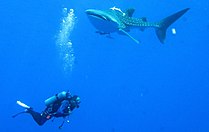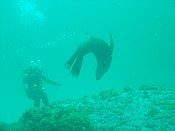
Water clarity is a descriptive term for how deeply visible light penetrates through water. In addition to light penetration, the term water clarity is also often used to describe underwater visibility. Water clarity is one way that humans measure water quality, along with oxygen concentration and the presence or absence of pollutants and algal blooms.[1]
Water clarity governs the health of underwater ecosystems because it impacts the amount of light reaching the plants and animals living underwater. For plants, light is needed for photosynthesis. The clarity of the underwater environment determines the depth ranges where aquatic plants can live.[2] [3] [4] [5] Water clarity also impacts how well visual animals like fish can see their prey.[6] [7] [8] [9] Clarity affects the aquatic plants and animals living in all kinds of water bodies, including rivers, ponds, lakes, reservoirs, estuaries, coastal lagoons, and the open ocean.
Water clarity also affects how humans interact with water, from recreation and property values to mapping, defense, and security. Water clarity influences human perceptions of water quality, recreational safety, aesthetic appeal, and overall environmental health.[10] [11] Tourists visiting the Great Barrier Reef were willing to pay to improve the water clarity conditions for recreational satisfaction.[12] Water clarity also influences waterfront property values. In the United States, a 1% improvement in water clarity increased property values by up to 10%.[13] [14] [15] [16] Water clarity is needed to visualize targets underwater, either from above or in water. These applications include mapping and military operations. To map shallow-water features such as oyster reefs and seagrass beds, the water must be clear enough for those features to be visible to a drone, airplane, or satellite.[17] [18] Water clarity is also needed to detect underwater objects such as submarines using visible light. [19] [20] [21]
- ^ "Indicators: Water Clarity". US EPA. 2014-01-10. Retrieved 2022-12-31.
- ^ Moore, Kenneth A.; Short, Frederick T. (2006). "Zostera: Biology, Ecology, and Management". Seagrasses: Biology, Ecologyand Conservation. Dordrecht: Springer Netherlands. pp. 361–386. doi:10.1007/978-1-4020-2983-7_16. ISBN 978-1-4020-2942-4.
- ^ Moore, Kenneth A. (2004). "Influence of Seagrasses on Water Quality in Shallow Regions of the Lower Chesapeake Bay". Journal of Coastal Research. 10045. Coastal Education and Research Foundation: 162–178. doi:10.2112/si45-162.1. ISSN 0749-0208. S2CID 129867711.
- ^ Zimmerman, Richard C.; Hill, Victoria J.; Gallegos, Charles L. (2015-07-28). "Predicting effects of ocean warming, acidification, and water quality on Chesapeake region eelgrass". Limnology and Oceanography. 60 (5). Wiley: 1781–1804. doi:10.1002/lno.10139. ISSN 0024-3590. S2CID 3531398.
- ^ Tango, Peter J.; Batiuk, Richard A. (2013-09-04). "Deriving Chesapeake Bay Water Quality Standards". JAWRA Journal of the American Water Resources Association. 49 (5). Wiley: 1007–1024. doi:10.1111/jawr.12108. ISSN 1093-474X. S2CID 102492027.
- ^ Aksnes, Dag L. (2007). "Evidence for visual constraints in large marine fish stocks". Limnology and Oceanography. 52 (1). Wiley: 198–203. doi:10.4319/lo.2007.52.1.0198. ISSN 0024-3590. S2CID 27346763.
- ^ Aksnes, Dag L.; Nejstgaard, Jens; Saedberg, Eivind; Sørnes, Tom (2004). "Optical control of fish and zooplankton populations". Limnology and Oceanography. 49 (1). Wiley: 233–238. doi:10.4319/lo.2004.49.1.0233. ISSN 0024-3590. S2CID 29707960.
- ^ Benfield, Mark C.; Minello, Thomas J. (1996). "Relative effects of turbidity and light intensity on reactive distance and feeding of an estuarine fish". Environmental Biology of Fishes. 46 (2). Springer Science and Business Media LLC: 211–216. doi:10.1007/bf00005223. ISSN 0378-1909. S2CID 37881461.
- ^ Reustle, Joseph W.; Smee, Delbert L. (2020-04-23). "Cloudy with a chance of mesopredator release: Turbidity alleviates top‐down control on intermediate predators through sensory disruption". Limnology and Oceanography. 65 (10). Wiley: 2278–2290. doi:10.1002/lno.11452. ISSN 0024-3590. S2CID 219039786.
- ^ West, Amie O.; Nolan, Justin M.; Scott, J. Thad (2015-12-22). "Optical water quality and human perceptions: a synthesis". WIREs Water. 3 (2). Wiley: 167–180. doi:10.1002/wat2.1127. ISSN 2049-1948. S2CID 130635512.
- ^ Vant, W. N.; Davies-Colley, R. J. (1988). "Water appearance and recreational use of 10 lakes of the North Island (New Zealand)". SIL Proceedings, 1922-2010. 23 (1). Informa UK Limited: 611–615. doi:10.1080/03680770.1987.11897990. ISSN 0368-0770.
- ^ Farr, Marina; Stoeckl, Natalie; Esparon, Michelle; Larson, Silva; Jarvis, Diane (2014). "The Importance of Water Clarity to Great Barrier Reef Tourists and Their Willingness to Pay to Improve it". Tourism Economics. 22 (2). SAGE Publications: 331–352. doi:10.5367/te.2014.0426. ISSN 1354-8166. S2CID 151259019.
- ^ Moore, Michael R.; Doubek, Jonathan P.; Xu, Hui; Cardinale, Bradley J. (2020). "Hedonic Price Estimates of Lake Water Quality: Valued Attribute, Instrumental Variables, and Ecological-Economic Benefits". Ecological Economics. 176. Elsevier BV: 106692. doi:10.1016/j.ecolecon.2020.106692. ISSN 0921-8009. OSTI 1787639. S2CID 224858953.
- ^ Klemick, Heather; Griffiths, Charles; Guignet, Dennis; Walsh, Patrick (2016-11-02). "Improving Water Quality in an Iconic Estuary: An Internal Meta-analysis of Property Value Impacts Around the Chesapeake Bay". Environmental and Resource Economics. 69 (2). Springer Science and Business Media LLC: 265–292. doi:10.1007/s10640-016-0078-3. ISSN 0924-6460. PMC 6550325. PMID 31178627.
- ^ Walsh, Patrick; Griffiths, Charles; Guignet, Dennis; Klemick, Heather (2017). "Modeling the Property Price Impact of Water Quality in 14 Chesapeake Bay Counties" (PDF). Ecological Economics. 135. Elsevier BV: 103–113. doi:10.1016/j.ecolecon.2016.12.014. ISSN 0921-8009.
- ^ Corona, Joel; Doley, Todd; Griffiths, Charles; Massey, Matthew; Moore, Chris; Muela, Stephen; Rashleigh, Brenda; Wheeler, William; Whitlock, Stephen D.; Hewitt, Julie (2020). "An Integrated Assessment Model for Valuing Water Quality Changes in the United States". Land Economics. 96 (4). University of Wisconsin Press: 478–492. doi:10.3368/wple.96.4.478. ISSN 0023-7639. PMC 8128698. PMID 34017148.
- ^ Hogan, S; Reidenbach, MA (2019-11-07). "Quantifying and mapping intertidal oyster reefs utilizing LiDAR-based remote sensing". Marine Ecology Progress Series. 630. Inter-Research Science Center: 83–99. doi:10.3354/meps13118. ISSN 0171-8630. S2CID 202858129.
- ^ Coffer, Megan M.; Schaeffer, Blake A.; Zimmerman, Richard C.; Hill, Victoria; Li, Jiang; Islam, Kazi A.; Whitman, Peter J. (2020). "Performance across WorldView-2 and RapidEye for reproducible seagrass mapping". Remote Sensing of Environment. 250. Elsevier BV: 112036. doi:10.1016/j.rse.2020.112036. ISSN 0034-4257. PMC 8318156. PMID 34334824.
- ^ Duntley, Seibert Q.; Preisendorfer, R. W. (1952). The visibility of submerged objects. Final Report to the Office of Naval Research (PDF). Retrieved 2 January 2023.
- ^ Austin, Roswell W.; Taylor, John H. (1963). "Submarine visibility and related ambient light studies. SIO Reference 63-32". Scripps Institution of Oceanography, UC San Diego. Retrieved 2 January 2023.
{{cite journal}}: Cite journal requires|journal=(help) - ^ Smart, Jeffrey H. (2004). "How accurately can we predict optical clarity in the littorals?" (PDF). Johns Hopkins APL Technical Digest. 25 (2): 112–120. Retrieved 2 January 2023.


